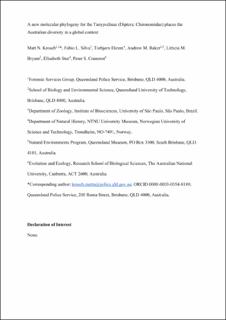| dc.contributor.author | Krosch, Matt N. | |
| dc.contributor.author | Silva, Fabio L | |
| dc.contributor.author | Ekrem, Torbjørn | |
| dc.contributor.author | Baker, Andrew M. | |
| dc.contributor.author | Bryant, Litticia M. | |
| dc.contributor.author | Stur, Elisabeth | |
| dc.contributor.author | Cranston, Peter S. | |
| dc.date.accessioned | 2021-10-21T06:52:30Z | |
| dc.date.available | 2021-10-21T06:52:30Z | |
| dc.date.created | 2021-10-19T09:26:49Z | |
| dc.date.issued | 2021 | |
| dc.identifier.citation | Molecular Phylogenetics and Evolution. 2022, 166, . | en_US |
| dc.identifier.issn | 1055-7903 | |
| dc.identifier.uri | https://hdl.handle.net/11250/2824307 | |
| dc.description.abstract | The non-biting midge subfamily Tanypodinae (Diptera: Chironomidae) is species-rich, ecologically diverse, and near-globally distributed. Within the subfamily, aspects of generic and species-level taxonomy remain poorly understood, in particular the validity of assignment of Australian and New Zealand taxa to genera erected for northern hemisphere (Holarctic) fauna. Here, we place the austral diversity within this global context by extensive geographical and taxonomic sampling in concert with a multilocus phylogenetic approach. We incorporated sequence data for mitochondrial COI, and nuclear 28S and CAD, and conducted Bayesian and maximum likelihood phylogenetic inferences and Bayesian divergence time estimation. The resolved phylogeny supported many associations of Australian taxa with their proposed Holarctic congeners, with the exception of Apsectrotanypus Fittkau, and validates several taxa as endemic. Three of four New Zealand sampled taxa had their sister groups in Australia; New Zealand Monopelopia Fittkau was sister to a German congener. This included the first record of Procladius Kieffer from New Zealand. Most nodes connecting austral and Holarctic taxa clustered around the Cretaceous-Tertiary boundary (60–80 mya), whereas New Zealand-Australia nodes were generally slightly younger (53–57 mya). Together, these data contribute substantially to our understanding of the taxonomy, systematics and biogeography of the Australian Tanypodinae and more broadly to knowledge of Australia’s aquatic insect biodiversity. | en_US |
| dc.language.iso | eng | en_US |
| dc.publisher | Elsevier Science | en_US |
| dc.relation.uri | https://www.sciencedirect.com/science/article/pii/S1055790321002578 | |
| dc.rights | Attribution-NonCommercial-NoDerivatives 4.0 Internasjonal | * |
| dc.rights.uri | http://creativecommons.org/licenses/by-nc-nd/4.0/deed.no | * |
| dc.title | A new molecular phylogeny for the Tanypodinae (Diptera: Chironomidae) places the Australian diversity in a global context | en_US |
| dc.type | Peer reviewed | en_US |
| dc.type | Journal article | en_US |
| dc.description.version | acceptedVersion | en_US |
| dc.source.pagenumber | 11 | en_US |
| dc.source.volume | 166 | en_US |
| dc.source.journal | Molecular Phylogenetics and Evolution | en_US |
| dc.identifier.doi | 10.1016/j.ympev.2021.107324 | |
| dc.identifier.cristin | 1946895 | |
| dc.description.localcode | This is the authors' accepted manuscript to an article published by Elsevier. Locked until 8 October 2023 due to copyright restrictions. The AAM is made available under the CC-BY-NC-ND 4.0 license http://creativecommons.org/licenses/by-nc-nd/4.0/ | en_US |
| dc.source.articlenumber | 107324 | en_US |
| cristin.ispublished | true | |
| cristin.fulltext | postprint | |
| cristin.qualitycode | 2 | |

